The parish’s churchyards were insufficient to cater for the rapid rise in population during the 19th century, from around 290 in 1790 to almost 5,000 in 1840, and land in Smallcombe Vale was purchased for St Mary’s Churchyard. This secluded valley lies between Bathwick and Widcombe Hills and can be reached from Horseshoe Walk up a 300m private road. The mortuary chapel was consecrated in 1855 and the land consecrated in 1856. The original sections (A-E) were extended in 1907 doubling its size. There were 5,173 burials and burial of ashes continues.
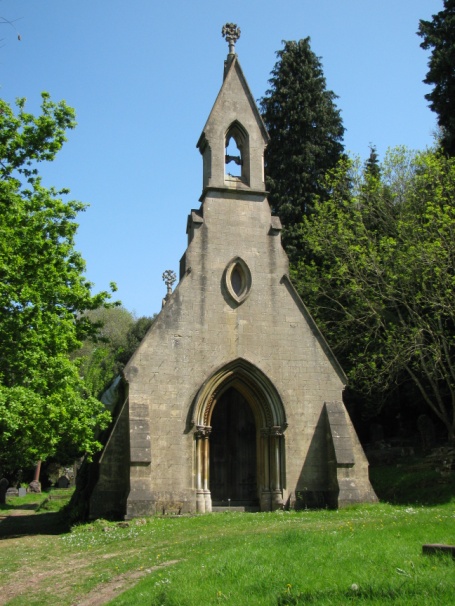
Mortuary Chapel
|
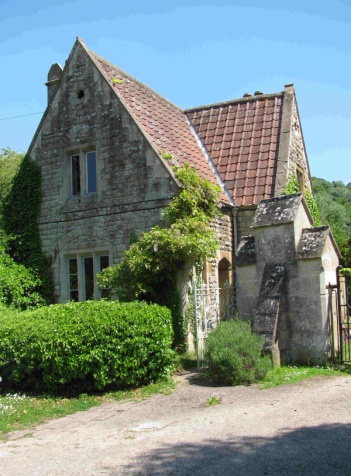
Lodge
|
The cemetery has lower, sloping sections on the northern side, the ground rising going south. South of Section A, the ground rises steeply to an upper terrace (Section B).
In 2012 the ‘Friends of St Mary’s Churchyards’ suggested to the Council that the graveyard be strimmed only annually, rather than monthly during the growing season, in exchange for more frequent mowing of the paths and removal of undergrowth. This led to some complaints on the grounds that, away from the paths, locating a grave was difficult and hazardous due to the long grass and an article appeared in the Bath Chronicle of 6-Sep-2012. A letter of complaint to the newspaper appeared in the 17-Nov-2012 edition.
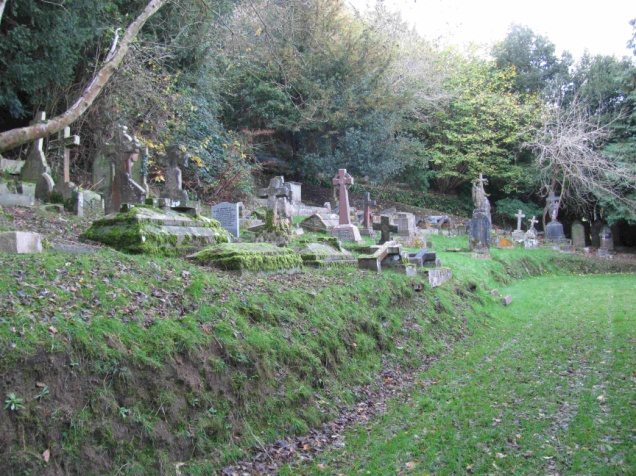
Part of Section A
|
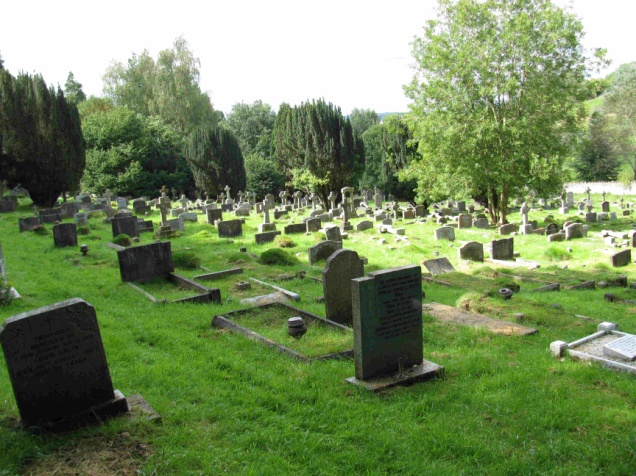
Section H
|
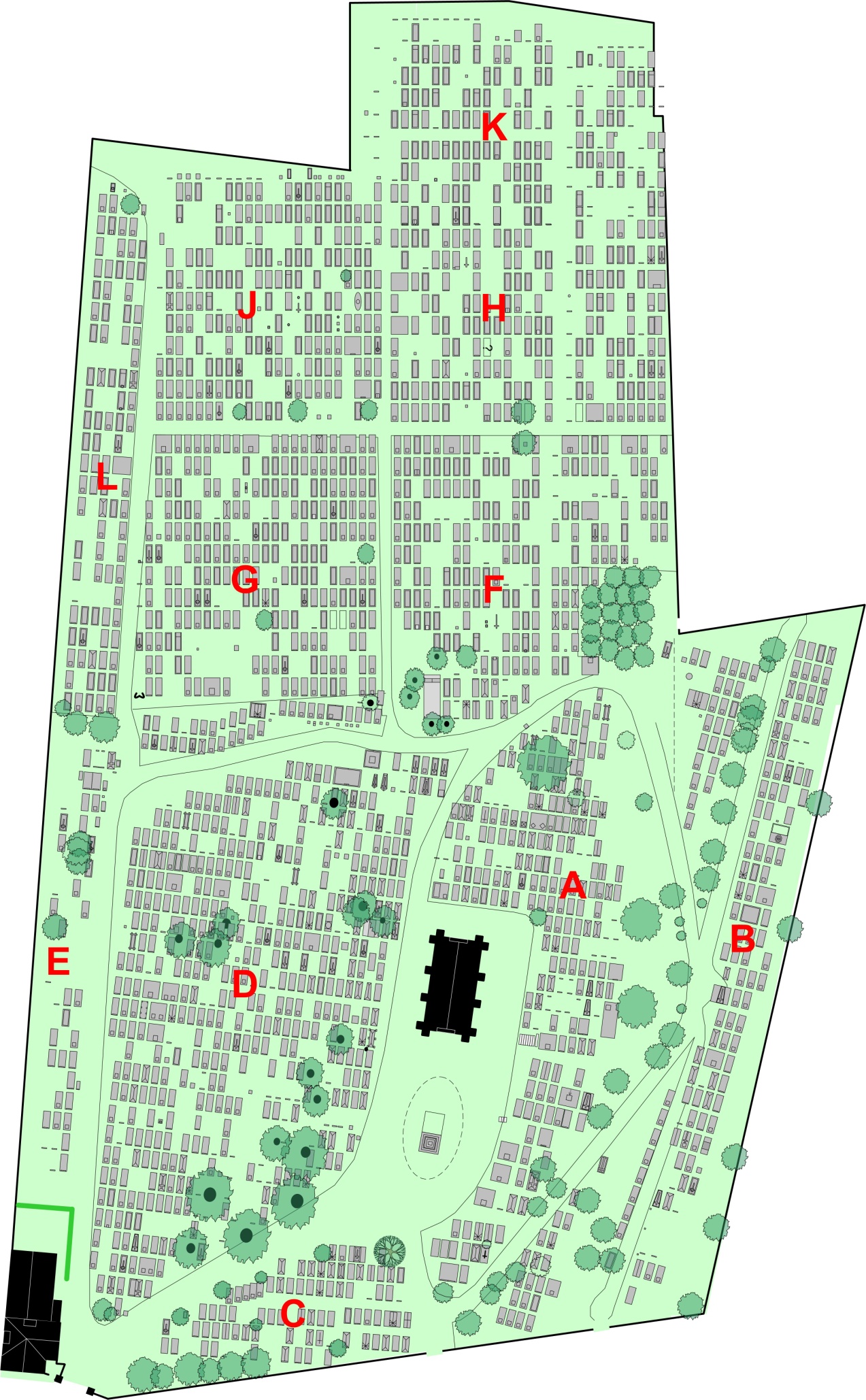
Layout of St Mary's Churchyard, Smallcombe Vale
|
The original layout of the graveyard included only those sections labelled A-E. The whole area was considered as one simple grid of rows and plot for sections A and C-E with section B as a separate ‘upper terrace’ with an ‘east bank’ and a ‘west bank’ on the slopes to the east and west of Section A. In practice, the rows in the western part of Section A are not quite aligned with the grid and, in Section C, one row has a series of graves along the path that do not conform to the grid.
The row letters start at ‘A’ on the eastern side through the alphabet to ‘U’. The occurrence of row identifiers such as ‘Da’ ‘Pa’ etc suggest that the original layout had pairs of rows with, in between each pair, a path and that, subsequently, the paths were also used. This is confirmed by the map of the pre-1907 layout. Later, rows Y, Z and OZ were added on the eastern border. In the burial order books and the associated index the locations of the graves are given simply by a row letter and plot number. The numbering of the graves is from 1 on the upper, southern side up to 60 on the lower, northern side. There is an exception to this for burials in the area which is designated here as Section B, with only an indication of one of ‘upper terrace’, ‘east bank’ or ‘west bank’.
In 1907 the graveyard was extended by the addition of the sections labelled F-L. After this the location of a grave was qualified by ‘new ground’ or ‘old ground’. This was necessary because the same alphabetic identification of rows was used for the new ground meaning that a simple row/plot combination would not identify a single grave. The whole of the ‘new ground’ was considered as single grid with the numbering of the graves starting at 1 on the lower, northern boundary and increasing going up the hill.
For convenience in identifying the location of grave, the identification the row/plot combination has been supplement by an alphabetic area identifier in the range A-L. For Section B, the sub-areas are identified by B1, B2 or B3 as the numbering of plots within a row does not follow a simple scheme.
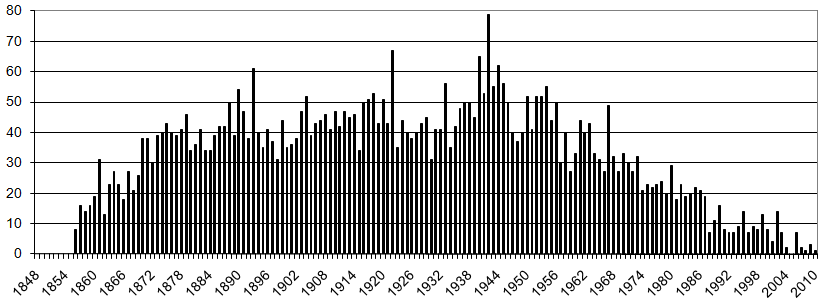
Number of burials per year
|
The Chapel
As described in the press report of its opening, the design of the churchyard’s
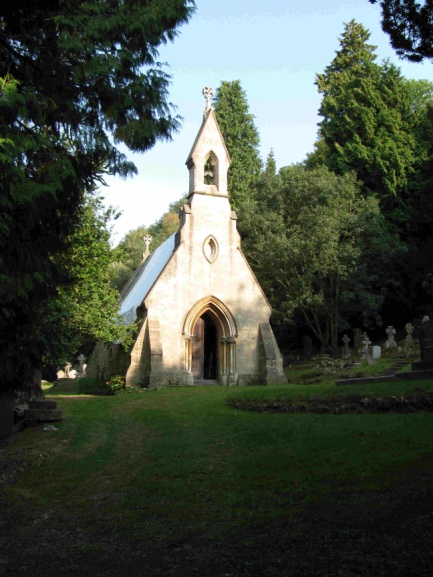
Chapel
|
mortuary chapel was awarded to Thomas Fuller, son of a Bath mayor. Thomas Fuller was employed as the architect with George Mann as the builder. The corner stone of was laid on 9 May 1855, using a silver trowel in accordance with the custom at that time. A cavity had been prepared beneath the stone and into which a sovereign, shilling and penny had been deposited.
It was made redundant in 1992 and sold to a builder who intended to make it a music studio. The conversion to a studio never happened and it was then sold by auction in 2008 (guide price £70,000) but on 9 Apr 2008 it was given Grade II listing, for the following reasons:
- The building is a well-preserved and picturesque example of a mid-C19 cemetery chapel.
- It is an elegant and well-proportioned chapel by a recognised architect, Thomas Fuller, who designed other listed buildings in the area.
- The building is largely unaltered since its completion in 1856, and retains its interesting scissor-braced roof structure intact.
- The chapel is intimately connected with its setting, playing a pivotal role in the landscape design of the cemetery.
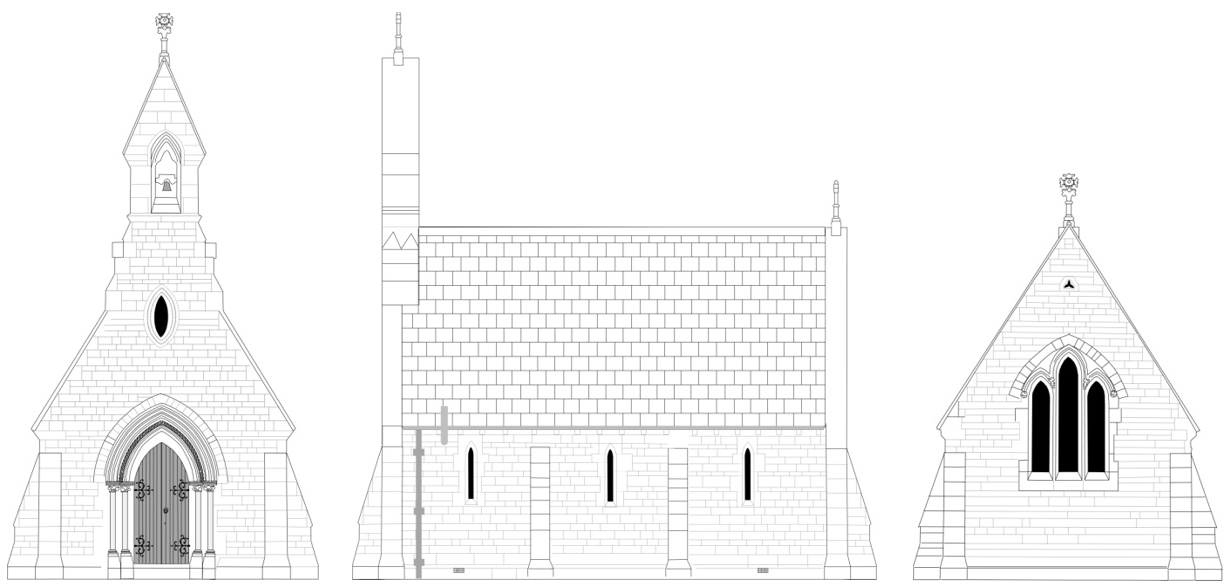
Sketches of the Western, Southern and Eastern walls of the chapel
The design of the stonework around the door is very similar to that found around the two doors of the southern side of St Michael’s in Broad Street and the door of the mortuary chapel in Perrymead cemetery. For the latter, the iron-work on the door is the same but the carving around the door has the band of small crosses/leaves replaced by a carved quotation in Latin and there are two heads, one of a pope (because there are three crowns) and a mitred bishop.
The Lodge
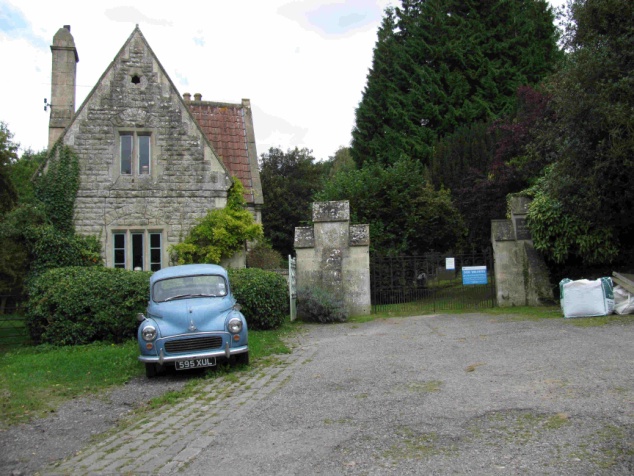 |
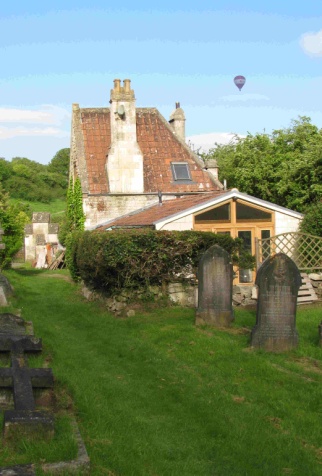 |
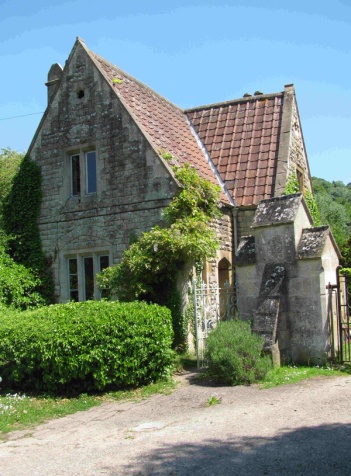 |
|
The lodge (left) and the entrance to the churchyard (right)
|
The lodge from the East and West
|
The lodge by the entrance to the churchyard was for housing the superintendant. According to the press report on the consecration of the cemetery in 1856, it had not been built at that time. The gardeners/superintendants, as listed in the Bath Directories and elsewhere, were:
- John Smith. In the 1861 census at Cemetery Lodge (by Smallcombe Farm), Bathwick, Bath: John Smith, aged 58, grave-digger, born at Milverton (Som), and wife Caroline, aged 30, born at Oakhill (Som).
- George Gammon 1876-1903. He died in 1903 and was buried in Section E, an area close to the lodge
- William Henry Edwards. He died aged 40 in 1907 and the burial register entry has his address as ‘The Lodge Bathwick Cemetery’
- Thomas Spanswick to about 1940.
- George Day from about 1947 to about 1968. He lived at Odd Down and the directories show that from 1952 to 1968 the lodge was occupied by someone other than the superintendant.
- J Hames from 1969.
The building was later sold and is now a private residence.
Notable Memorials
|
A.A.13
|
John Hay Maitland Hardyman (1894-1918)
Not buried here but there is a memorial. Youngest Lieutenant-Colonel in the British Army. Awarded a D.S.O. and an M.C.
|
|
A.Ha.3
|
Harriet Malthus (1776-1864)
Wife of Thomas Robert Malthus (1766-1834) a noted British scholar whose ideas on society and economics and, in particular population growth, the Corn Laws and Poor Laws were influential on people such as William Pitt the Younger, Charles Darwin and Alfred Russel Wallace. Robert Malthus was buried in Bath Abbey.
Two of her sisters, Clara Eckersall (1792-1869) and Ann Eliza Wood (1790-1875), are buried in an adjacent grave.
|
|
B2
|
Housman
The memorial (a sundial on an octagonal base) is to all the children of Edward & Sarah Housman, of whom one was the author Alfred Edward Housman (1859-1936). A E Housman was buried at Ludlow but a brother and two sisters are buried here.
|
|
B2.Ca.11
|
George Vincent Fosbery (1832-1907)
He was awarded a Victoria Cross for daring and gallant conduct during the Umbeyla Expedition of 1863. He invented and patented the semi-automatic self-cocking revolver which bears his name and manufactured by the Webley & Scott Revolver & Arms Company– Webley-Fosbery.
|
|
C.S.7
|
Moses Pickwick (1781-1869)
From the family of Pickwicks from Corsham whose ancestor, also Moses Pickwick, ran a coach business and whose name was used by Charles Dickens.
|
|
C.T.18
|
Charles Edward Davis (1829-1902)
A notable local architect who was responsible for overseeing the excavation of the Roman Baths. The monument is in the form of a Saxon cross, one of the discoveries during the excavation.
|
|
D.K.23
|
William Clark Russell (1844-1911)
He was the author of a large number of novels of heroism and adventure at sea. As a testament to his popularity in the Sherlock Holmes story The Five Orange Pips, Doctor Watson is described as 'deep in one of Clark Russell's fine sea stories'.
|
|
D.W.42
|
George Astley Callaghan (1852-1920)
Command-in-Chief of the Home Fleet of the Royal Navy until the outbreak of the First World War. His burial service was in Westminster Abbey.
|
|
D.Z.28, 29
|
Lieutenant-Colonel Thomas George Montgomerie (1830-1878)
A member of the Great Trigonometric Survey of India which mapped India and attempted to map Nepal and Tibet using subterfuge to put surveyors into those countries.
|
|
H.M.51
|
Herbert Asquith (1881-1947) and Cynthia Asquith (1887-1960)
Second son of the Prime Minister. The memorial describes him as ‘poet and soldier’. His wife Cynthia was a close friend of D H Lawrence and in 1918 became secretary to J M Barrie and remained so until his death in 1937.
|
|
H.T.58
|
Frederick Edward Weatherly (1848-1929)
Barrister but better known for being the composer of Danny Boy and Roses of Picardy.
|
|
A.T.11
|
Joseph Edward Stephen Theweneti (1805-1869)
Artist and photographer. Member of a family that had come from Romania (then part of ‘Turkey in Europe’). He and his brothers Michael and Lorenzo were miniature & portrait painters.
|
|
H.S.58
|
Sir Arthur Carlton (1865-1931)
Theatre manager including 1914-1931 owner/manager of Bath’s Theatre Royal.
|